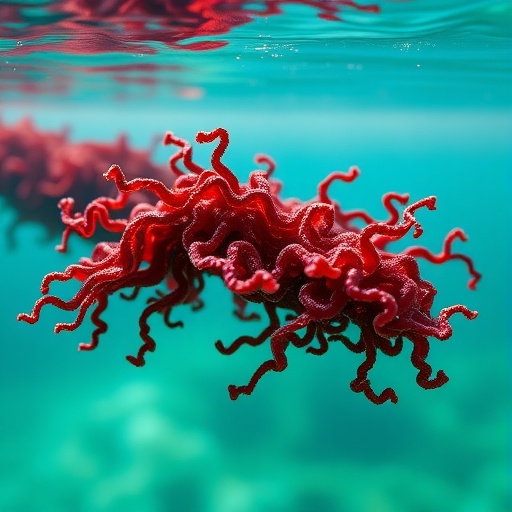In an innovative study shedding light on environmental sustainability in aquaculture, researchers have found significant potential in utilizing the red seaweed species Agardhiella subulata for the dual removal of ammonium and carbon from aquaculture effluent. The findings, published in the Environmental Science and Pollution Research journal, underscore the capability of this marine plant to address two pressing issues in the aquaculture sector—nutrient pollution and carbon emissions.
Aquaculture has increasingly become a vital food production method worldwide, yet the environmental impacts stemming from uneaten feed and animal waste present considerable challenges. Nutrient enrichment of water bodies—primarily due to nitrogen and phosphorus inputs—can lead to harmful algal blooms and ecosystem imbalances. Thus, methods to mitigate these inputs are crucial for maintaining ecological balance in aquatic environments.
The study by Xu et al. emphasizes the potential of using Agardhiella subulata not just as a biofilter, but also as a means to valorize aquaculture waste. The researchers conducted experiments to assess the efficiency of this red seaweed in removing ammonium, a toxic byproduct of fish excretion, as well as carbon dioxide, a significant contributor to greenhouse gas emissions. Their results indicated a synergistic effect, where the presence of ammonium in the effluent enhanced the seaweed’s capability to absorb carbon.
This phenomenon is attributed to the natural biochemical pathways that Agardhiella subulata employs in its metabolic processes. By stimulating photosynthesis, the seaweed captures carbon dioxide from the surrounding water, facilitating the transformation of these pollutants into biomass, which can later be utilized in various applications. This finding not only presents an eco-friendly solution to waste management in aquaculture but also highlights the economic potential of cultivating red seaweed in coastal regions with existing aquaculture infrastructure.
Furthermore, the implications of this study extend beyond just aquaculture. The integration of red seaweed cultivation into existing fish farming practices could enhance food security while simultaneously addressing climate change. As the global demand for seafood continues to rise, sustainable practices must be adopted to prevent overfishing and excessive environmental degradation. This approach promotes a circular economy where waste products are converted into valuable resources, thereby closing the nutrient loop in aquaculture systems.
The research conducted by Xu and colleagues involved a series of controlled experiments designed to evaluate the efficacy of Agardhiella subulata in assimilating ammonium and carbon. By varying concentrations of these compounds in the effluent, the team was able to determine optimal conditions under which the seaweed thrived and exhibited high absorption rates. The findings revealed impressive percentages of ammonium and carbon removal, supporting the hypothesis that red seaweeds could operate as a natural filter for aquaculture runoff.
In addition to removing harmful substances from water, the cultivation of Agardhiella subulata presents an opportunity for carbon sequestration, a critical element in combating climate change. The atmospheric carbon absorbed during photosynthesis can be stored in the biomass of the seaweed, offering a potential pathway for mitigating the effects of carbon emissions from aquaculture practices. This dynamic opens the door for innovative climate action strategies that leverage marine resources for environmental benefits.
The study raises pivotal questions about the role of seaweed in sustainable aquaculture and broader marine conservation efforts. As researchers continue to explore the versatile applications of marine plants, there is an increasing realization that nature holds key solutions to many of our contemporary challenges. The shift towards integrating biological solutions into aquaculture practices could redefine how we manage marine ecosystems and utilize natural resources.
This research is timely, considering the growing awareness of the detrimental impacts of climate change. By fostering synergies between aquaculture and marine vegetation, stakeholders can boost economic resilience while simultaneously protecting vulnerable aquatic ecosystems. Transitioning to more sustainable practices in aquaculture will require collaboration across various sectors, including policy-makers, environmentalists, and business owners committed to fostering a greener future.
The study also emphasizes the importance of scaling up these innovative practices. While the laboratory results are promising, the next step involves translating these findings into real-world applications. Large-scale trials that implement Agardhiella subulata in aquaculture operations will be necessary to fully understand its capabilities and viability as a sustainable practice. Moreover, public awareness and community involvement will be essential in promoting the adoption of seaweed cultivation alongside traditional aquaculture methods.
In conclusion, this groundbreaking research underscores the significant role that Agardhiella subulata could play in transforming aquaculture into a more sustainable industry. The synergistic removal of ammonium and carbon demonstrates an innovative approach to combatting the environmental challenges posed by modern aquaculture practices. As the scientific community continues to unravel the complexities of marine ecosystems, the potential for harnessing natural solutions for environmental sustainability remains vast and promising.
By embracing such innovative approaches, we can cultivate a more resilient and sustainable future for aquaculture, ensuring that we meet the nutritional needs of a growing global population while preserving the health and balance of our marine environments.
Subject of Research: The utilization of red seaweed Agardhiella subulata for removing ammonium and carbon from aquaculture effluent.
Article Title: Synergistic ammonium and carbon removal in aquaculture effluent using red seaweed Agardhiella subulata.
Article References:
Xu, ZY., Chen, B., Kuo, CH. et al. Synergistic ammonium and carbon removal in aquaculture effluent using red seaweed Agardhiella subulata.
Environ Sci Pollut Res (2025). https://doi.org/10.1007/s11356-025-36892-5
Image Credits: AI Generated
DOI:
Keywords: Aquaculture, Agardhiella subulata, ammonium removal, carbon sequestration, sustainable practices.




